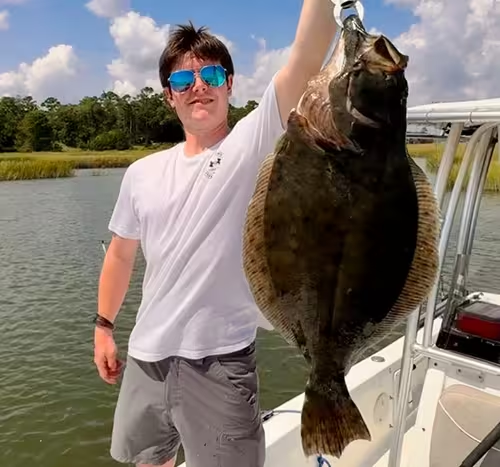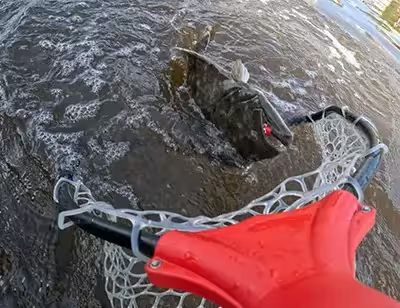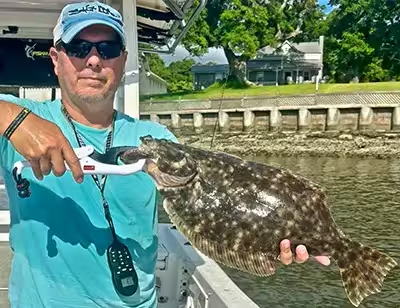Protecting NC Flounder While Restoring Access to Anglers

Flounder regulations in North Carolina have become one of the most debated topics in our coastal fisheries. Recreational anglers once enjoyed a liberal 15-inch minimum size and a five-fish daily limit. Today, we’re down to a two-week season with a one-fish-per-person rule — a drastic shift that has created frustration, confusion, and controversy up and down the coast.
But there’s also a bright side: the moratoriums appear to have worked. In recent years, we’ve seen a big rebound in flounder numbers and size — fish in the 20- to 24-inch range are now common again, with some pushing 28–29 inches.
The problem is what happens next. When the brief season finally opens, the pent-up demand creates a “fishing frenzy” that wipes out many of those larger, mature fish within days. Rivers that were full of big flounder the week before suddenly feel empty by the end of the second week. In my view, that’s proof that the current system — short, high-intensity seasons — is actually counterproductive.
If the goal is to rebuild and maintain a healthy population, then pulling nearly all of those post-moratorium fish out in a 10- to 14-day rush simply resets the cycle. A steady, low-impact, year-round harvest would be far better for both anglers and the resource.
My recommendation is simple: keep the bag limit conservative at one flounder per person per day, but raise the minimum size to 20 inches and reopen the season year-round. That approach would protect younger fish, reward patient anglers, and spread harvest pressure evenly instead of creating a two-week gold rush that drains local waters. It’s a fair, sustainable compromise — conservation first, but with access restored for everyday fishermen.
NC Flounder Regulations: From Abundance to Restriction
Years ago, flounder fishing along the North Carolina coast was steady and predictable. Recreational anglers could keep up to five flounder per day, as long as each fish measured at least 15 inches. Those generous limits supported a thriving coastal fishing culture, with countless visitors booking charters and local guides relying on a dependable seasonal draw.
But as participation grew and technology made anglers more efficient, total harvest climbed. Both the recreational and commercial sectors began landing more fish, and over time, biologists warned that the population wasn’t reproducing fast enough to sustain the pressure. That warning set the stage for the regulations we see today.
Flounder Stock Assessments in NC: Why the Data May Be Wrong

The North Carolina Division of Marine Fisheries (NCDMF) declared southern flounder “overfished” and implemented the Southern Flounder Fishery Management Plan (FMP) to rebuild the stock. The decision was based on stock assessments that indicated declining abundance and rising mortality. Those assessments led to strict harvest limits, closed seasons, and even complete moratoriums in certain years.
However, the science driving those decisions is now under scrutiny. The stock assessments that labeled flounder overfished are several years old and rely on pre-moratorium data that no longer reflects the fishery we’re seeing today. Anglers up and down the coast — myself included — are catching more and bigger fish than ever, which suggests the population has rebounded substantially, yet that progress is quickly undermined each year during the short, fast-and-furious harvest season when most of those mature fish are removed almost at once.
While anecdotal observations don’t replace formal stock assessments, the growing disconnect between what biologists predicted and what anglers are witnessing firsthand suggests the upcoming 2025–2026 assessment may reveal significant population recovery.
Recognizing this disconnect, the State of North Carolina has ordered NCDMF to conduct a new flounder stock assessment using updated data from both recreational and commercial fisheries. This new “fish count” is required by law to be completed no later than July 1, 2026, and should finally give a clear, up-to-date picture of the flounder population’s true health. Many believe that once the results are released, they’ll confirm what we’re already witnessing on the water: a strong, healthy comeback for North Carolina’s flounder — but at the very least, we’ll finally have recent data rather than relying on figures from years when the fishery looked far different than it does today.
The Current 2025 Flounder Regulations (At a Glance)
For 2025, the recreational flounder season runs from September 1 through September 14 — just two short weeks. Anglers are limited to one flounder per person per day, and each fish must measure at least 15 inches in total length. These rules apply uniformly across coastal, joint, and inland waters, and both hook-and-line and gigging are allowed where legal.
Commercial harvest remains under a quota system with a total allowable catch (TAC) divided between the commercial and recreational sectors. For 2025, the allocation remains at 60% commercial and 40% recreational under the phased schedule that began with Amendment 3. However, with the passage of Amendment 4, that split will shift to an even 50/50 allocation starting in 2026 — a change widely supported by the recreational community and viewed as a major step toward fairness and shared conservation responsibility. The Atlantic Ocean commercial flounder trawl season opens April 26, 2025, with 15,000-pound trip limits, while inshore commercial flounder harvests continue to be governed by area-specific proclamations and quota tracking.
The Controversy — Data, Fairness & the “Fishing Frenzy”

Outdated Science & Angler Distrust
Many anglers feel the current system is being managed by old science. When you’re seeing 20- to 24-inch flounder in nearly every creek and river, it’s hard to accept that the fishery is still “overfished.” Using outdated assessments to justify new closures has created a trust gap between NCDMF and the fishing community. The upcoming state-ordered stock reassessment is an opportunity to rebuild that trust with transparent, data-driven management decisions.
Boom-and-Bust Harvest Pressure
The short, two-week season is a perfect storm for overharvest. As soon as it opens, flounder fishing turns into a statewide event. Boats launch before dawn, ramps overflow, and pressure skyrockets. Within days, the same creeks that held dozens of keeper-sized flounder are fished nearly clean.
The irony is that this concentrated harvest can do more damage than a modest, steady year-round fishery. Instead of letting anglers take one fish here and there throughout the year, the current “race to harvest” system encourages maximum effort all at once — which defeats the conservation purpose of the closure in the first place.
Recreational vs. Commercial Disparity
Adding to the frustration is the perception of imbalance between recreational and commercial harvest rules. Recreational fishermen endure months-long closures and strict limits, while commercial operations continue to fish under their allocated quotas. Commercial operators counter that their catches are carefully monitored and limited by law — but for the average angler, it’s hard not to feel shortchanged.
To be fair, most commercial fishermen face their own challenges — from costly gear, fuel, and insurance to tight regulations and unpredictable weather windows. Many depend on seasonal flounder harvests to support their families and coastal communities. They’re not the enemy; they’re fellow stewards of the same resource, and any sustainable plan must account for their livelihoods alongside recreational access.
The planned gradual move toward a 50/50 allocation will go a long way toward restoring faith and fairness between both user groups, ensuring that conservation responsibility — as well as access — is shared equally.
Ripple Effects on Other Species
Another side effect of these closures is the pressure shift they cause within the inshore ecosystem. When flounder and trout are both closed, anglers naturally focus on Red Drum, North Carolina’s state fish. The result is an unsustainable spike in redfish pressure, especially in summer months. This kind of “regulatory squeeze” hurts the entire balance of our coastal fishery and shows why multi-species coordination is essential.
What I’m Seeing on the Water

Even during closed seasons, we're catching plenty of flounder — and they're big. Fish in the 20- to 24-inch range are very common, and my charter clients have landed flounder up to 29 inches this summer.
That proves the population is strong, but the short season leads to quick depletion once harvest resumes. In my area, I've watched rivers go from loaded with flounder in late August to nearly empty a week after the season opens.
The fishing frenzy style season does raise questions as to whether or not any stock assessment will be accurate.
A slower, steadier harvest model would maintain those healthy numbers year-round and prevent sharp swings in flounder abundance before or after stock assessments.
A Better Path for NC Flounder Conservation and Angler Access
The good news is that there’s a middle ground that can protect the resource without shutting anglers out. A sustainable flounder plan doesn’t have to be extreme — it just has to be balanced and consistent.
As I mentioned earlier, one logical framework would be to reopen the season year-round (or for at least six months) but raise the size limit to 20 inches and maintain the one-fish-per-day rule. This allows flounder to reach maturity and spawn at least once before being harvested while giving anglers a realistic opportunity to keep a fish here and there.
Other key improvements could include:
- Addressing trawl bycatch and discard mortality that silently reduces stock numbers
- Coordinating flounder, redfish, and trout seasons to prevent “effort dumping” on one species
- Publishing quarterly data updates on quotas and population trends to maintain transparency
- Strengthening inshore sound, marsh, and nursery protections where juvenile flounder develop
A system like this would let North Carolina anglers enjoy responsible access while protecting the long-term health of our coastal fishery.
Conservation First — But Access Matters Too
Conservation and access aren’t opposites — they depend on each other. A balanced system allows anglers to participate without jeopardizing recovery. My philosophy is simple: protect the future, but let responsible anglers enjoy it in the present. A 20-inch, one-fish, year-round limit does exactly that — cautious, fair, and enforceable.
Looking Ahead — What Comes Next
The upcoming NCDMF flounder stock assessment will be a defining moment. If it confirms stock recovery, we could finally move toward data-driven management instead of legacy restrictions. Until then, anglers should stay informed, attend hearings, and continue practicing catch-and-release conservation. With solid science and level-headed leadership, we can find the middle ground — a thriving fishery and fair access for all.
Captain’s Note: Why Responsible Anglers Matter

I’ve spent most of my life chasing flounder and other inshore species along the Carolina coast, and I’ve come to believe something deeply: if you take the anglers out of the equation, the fish lose their greatest ally. Responsible fishermen — like responsible hunters — care more about the long-term health of the resource than anyone else. We’re the ones who see the changes firsthand, who pass on the ethics of catch-and-release, who teach kids how to respect what swims beneath the surface.
When anglers are engaged, educated, and part of the conversation, the fishery thrives. When they’re pushed out or ignored, stewardship suffers. We need management that protects the resource and keeps people connected to it — because the future of flounder fishing depends on both.
The author is a full-time charter captain in Ocean Isle Beach NC. Captain Harvey specializes in inshore fishing. His thoughts and observations in this article come from hundreds of inshore fishing charters each year, as well as from his own personal time on the water. Feel free to reach out to Captain Harvey with any questions or comments.

Tight Lines,
Captain Harvey Wall
Salty Dawg Fishing Charters
Updated: November 6, 2025